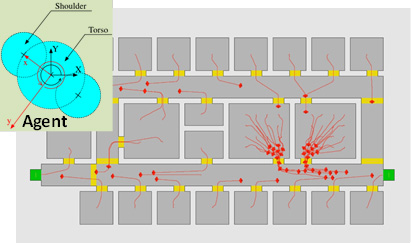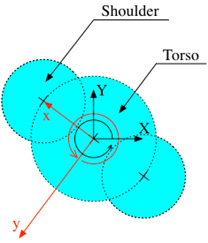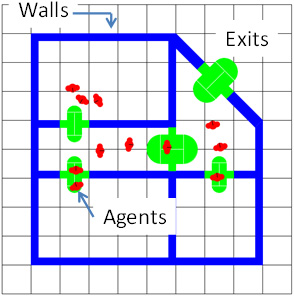Sherif El-Tawil, PhD, PE
Professor and Associate Chair
Department of Civil & Environmental Engineering | The University of Michigan
Egress Simulation Using Agent Based Models

New agent based models were developed to investigate how people respond and egress during emergencies. The new models that have been developed account for physical considerations, e.g. agent size, speed, etc., as well as group and social effects, e.g. influence of friends and close kin, memory, exchanged information, etc.
Agent based modeling (ABM) is a computational simulation methodology used to build an artificial society. The simulation is populated with computer-driven agents that have their own characteristics, are different from others, and are adaptive and capable of interacting with each other and with their environment. The interactions of interdependent agents generate complex systems, usually understood as emergence, that otherwise could not be obtained through the addition of the parts. ABM provides information relevant to the conduct of experiments for which real-world data collection would be unethical, impractical, or prohibitively expensive, hence its use for the proposed work.
The new ABM developed in this research is one of the first models to incorporate group social behavior as discussed in the next section. The majority of existing models to date are based upon the "sole actor" model, where every person makes selfish evacuation decisions based on self-preservation. Current social science theories have disproved the so-called panic egress mode, and indicate that people interact socially during evacuation, issues that are now considered in the developed model.

The body shape of an Agent.

Agents freely navigating in 2-D space.
A novel method for modeling the thinking and prioritization processes of a human being in an emergency situation was recently developed. The method, which is termed Scalar Field Model (SFM) is based on analogy to a charge within an electrical field or a particle in a gravitational field. The method has some similarities to the Social Force Model proposed by Helbing and co-workers, but has several major advantages and benefits, including: 1) the scalar nature of the model makes handling it easier than the vector-based social force model, 2) there is a clean delineation between social effects and physical force, unlike the social force model, and 3) can more naturally extend to leadership issues, e.g. agents can naturally take on leadership or follower roles.
The new model permits agents to make human-like decision in a rational manner. Specifically, agents can:
- Make autonomous decisions about route selection based on current conditions or memory and without intervention from a user or hardwiring within the code, as is the case in most existing egress methodologies.
- Naturally models the preference of humans to face a target point of interest.
- Appreciate the level of urgency and respond appropriately, for example, agents could move closer to other agents and obstacles during an emergency, but maintain a greater buffer during 'normal' times.
- Account for the degree of aggression during egress, e.g. an agent can be made to have the predisposition to cut across the path of other agents during egress.
- Most importantly, account for social bonds. For example, the model can easily and naturally account for strong or weak bonds between agents. Strong bonds could be between spouses or kin, while weak bonds could be between friends. Agents may move against the flow of other agents in their quest to reach a relative or friend.
- Be able to easily take on leadership or follower roles. Followers become more attracted to a leader and therefore want to stay close to them. Follower/leader roles can be terminated at any time, as needed, to reflect the death/loss of a leader.
The newly developed model is powerful because it can naturally handle conflicting or additive considerations in the decision making process of an agent. In contrast, most other approaches entail conditional logic or judgments, which makes it almost impossible to consider situations where there are conflicting emotions or memories. Moreover, the proposed method can be efficiently and easily scaled up to address a large network of individuals.
Animations
Learn more about the capabilities of the agent based technique by clicking on the animations below.